The numbers were almost unreal for Dan Foley to comprehend. Forty marathons over a ten-year span.
“I can’t believe we’re going back a decade when I started this journey,” he said as he reflected on his accomplishment back in June from a corner booth at Tony’s Pizza in Sutton. “That’s crazy!”
The Uxbridge resident set this simple goal at age thirty to complete 40 marathons by his 40th birthday and he did it. “When it happened, I was so excited and happy,” said Foley, but as he spoke these words, there was a surprising hint of somberness in his voice. He ran number forty on May 2, 2021 in Providence, RI. However, as the euphoria of such a feat dissipated, a feeling of melancholy has since set in Foley’s mind. Although proud of his accomplishment, he was unsure about his future in the sport.
“What next?” he asked out loud. Foley has grappled with this question as an ongoing inner monologue ever since, but he could not help blurt it out over casual conversation. For every marathon he finished, Foley always had the ability to channel his energy to get his mind and body ready for the next race. But something changed when he finally reached his ultimate goal. Crossing that finish line in Providence was the end of something special; something great, but it was over and all he could ask was “what’s next?”
“The last two weeks I really hadn’t had the motivation to run,” he said. His eyes danced across the empty table as if he lost something. “I really hadn’t had the motivation to do anything.”
Foley has gone through many different training and diet incarnations over the last ten years in preparation for each 26.2-mile race. He drove himself to be fit enough to run at race pace for 1,048 miles through pouring rain, severe heat, or bitter cold. He had to be persistent to put his body through such harsh running conditions. That’s a lot of mileage on one set of legs. “I was just kind of burnt out,” he said. “I was kind of worried this would happen … If I don’t have a ‘what’s next’ am I going to be, ok? I haven’t been and I was kind of lost.”
What Motivates?
When Foley initially set the goal to run forty marathons by age 40 in 2011, he had just turned 30 with a grand-total of one marathon under his belt. He had no idea what he was truly in for. From then to now, his workouts evolved. He has dealt with injuries and various obstacles along the way, while balancing his growing family for ten years. His purpose to run changed as well. There were many factors motivating him to persevere through 6 a.m. morning runs and gym workouts. This married father of two, who never played any organized sports growing up, who was a self-proclaimed “couch potato,” made it his mission to accomplish the seemingly insurmountable feat of finishing forty marathons within a ten-year span.
“I needed a reason to keep running and I was always able to find that motivation,” he said as he began to laugh. He then mentioned his motivation to eat junk food. “To be honest, I’ve had a sweet tooth ever since I was a kid and that’s been a problem of mine. That’s something I really haven’t figured out yet.”

Marine Corp 2012 with Dan Foley Sr. Submitted photo
Although not perfect, he has figured out how to finish marathons. He did get off the couch to run long distances about fifteen years ago. Unfortunately, it occurred after his father suffered a stroke. He decided to use his dad’s health recovery as inspiration to change the direction of his life. “That’s when I decided to run; to honor him,” Foley said. “It was the first time I did anything physical in my life. I wanted to do it for him.”
Foley knew it was going to be hard. He had to ease into it. He started with short races doing a few local 5K and 10K runs. “I didn’t think too much about it. I was doing it in honor of my dad,” he said. “It kind of gave me some motivation.” Adding further incentive, his wife Katie joined in honor of her great aunt, Kay Saucier, who died from a stroke.
“We’d go out to run together and it was kind of nice to share it with her,” Foley said. “We run at different paces so we don’t actually run together. We were just at the training sessions together.”
The Foley’s moved from 5K runs and advanced to half marathons. Kate Foley said their first experience running together was in the San Diego Rock & Roll 1/2 Marathon. “We trained and ran that race together,” she said. “But I can count on one hand the number of times we have run together since then. We sometimes train at the same time and run in the same events but we run at different paces and meet up at the end.”
“I think it was in 2008 where we ran the whole half marathon together, but after that I … kind of … got more competitive with it,” Dan Foley said. “I wanted to
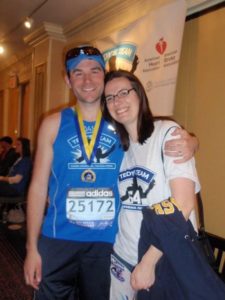
Dan and Kate Foley. Submitted photo
get fast so I started focusing more on that, plus she was pregnant and she had a few other things to worry about.”
Getting faster became a nice personal goal, but that wasn’t enough to keep him off the couch. There had to be a reason greater than himself. He still needed a cause. This led him to Tedy’s Team, a running group whose main goal was stroke awareness. More specifically, the group looks to make the general public mindful of the signs and symptoms of a stroke; they look to break the stigma of who can have a stroke; and they raise money to help fund life-saving stroke research. The charitable organization was founded in 2005 after Tedy Bruschi, former New England Patriot linebacker, suffered a stroke at age 31.
“Over the last nine years, Dan and his wife, Katie, have been a special part of our Tedy’s Team family,” Bruschi said. “They have raised close to $200,000 towards our mission, and have raised life-saving awareness of the warning signs of stroke.”
Foley’s first race with Tedy’s Team came during the seven-mile Falmouth Road Race in August of 2010. When the race was over, whether it was the extra endorphins pumping through his body or the sense of pride from crossing the finish line, something exciting stirred inside him. “Being at the afterparty at Falmouth, it kind of got me interested in what could be next,” he said with a fiery glow in his eyes. He was no longer searching the empty table. He looked engaged. “I thought, well, that was ok, but I want to do more now. I want to challenge myself … Why not try a marathon?”
Foley was selected to train for his first marathon with Tedy’s Team in October of 2010. The goal was to compete in the 2011 Boston Marathon in April. He recalled a creeping feeling of self-doubt. “I was nervous,” he said. “To think, will I be able to do this? Could I do this without getting injured? What was I thinking? … The longest I ran up to that point was a half marathon and it was a long one. It was two hours or two-and-a-half or something of that nature and I wasn’t a fast runner and I wasn’t a very strong runner. Could I really do this?”
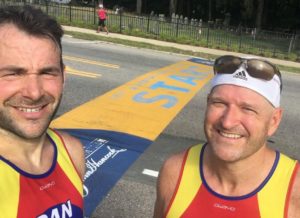
Selfie at the starting line. Foley with his friend and running partner, Mike Lawrence. Submitted photo
Michael Lawrence, Foley’s longtime friend and running partner, knew self-doubt in his friend was only a temporary thing. “Distance running is all about perseverance,” Lawrence said. “Whether that’s the actual race, the training season or just the willingness to get to the start line, Dan took that to the extreme.”
Fortunately for Foley, Tedy’s Team had an experienced marathon coach, John Furey, to help. Furey has coached runners of all abilities for more than three decades. Since 1996, Furey has coached more than 3,000 Boston Marathon Charity runners. “They had a really good coach in place,” Foley said.
Foley was nervous before training, but learned quickly what Furey expected from him. His anxiety lowered when he realized the first training run was going to be reasonable. “Knowing your first run is going to be six to eight miles, you try to figure out what your fitness level is,” he said. This information put his mind at ease. “At that point I had done the Falmouth Road Race so I knew I could do seven miles without a problem.”
Training with Tedy’s Team and Coach Furey started in December of 2010. Foley had two months to prepare his body for the training. “Furey laid out a plan for us to see what the season was going to look like,” said Foley, who also had to balance his job as a claims department manager at Hanover Insurance in Worcester.
Lawrence watched Foley merge running into a regular daily routine. “Dan turned marathon running into a lifestyle,” he said. “When you set a goal that high you have to allocate a high amount of time and energy on a weekly basis, but do so every single week; no breaks. You can’t come and go from it like it is a hobby.”
That running lifestyle also had to include his growing family.
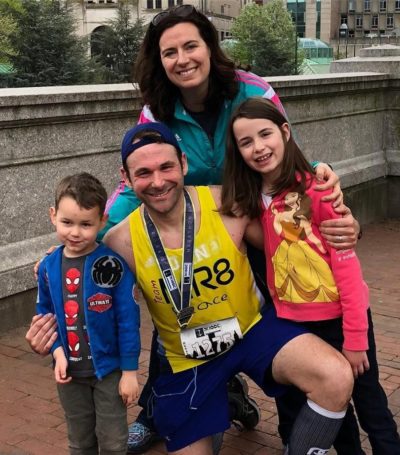
The Foley Family in Providence 2018. Submitted photo
Family balance
“From day one, the most important thing for me about this is I did not want it to impact my time with my family,” Foley said with a serious tone. “I wanted to meet the goal I had in mind, but it could not take away from family time. And yeah, there are a couple Saturdays where I got home late from Boston, but for the most part, my wife and I really supported each other through this. When she’s training or when I’m training, we make sure that the kids aren’t left with my parents or other people and that we’re always there for them and that they are part of it.”
His friend and running partner, Kimberly Sanger witnessed his family devotion firsthand. “Nothing is more important to Dan than his family,” Sanger said. “He makes sure that he takes time for his kids, but also his wife Katie. They are a great team.”
His wife said marathon training is a huge time commitment, but he makes it work. “I think people are usually surprised to hear my answer to this,” she said. “Dan has been marathon training since our daughter was a year old so it has always been part of our family life. The kids enjoy going to his races and seeing
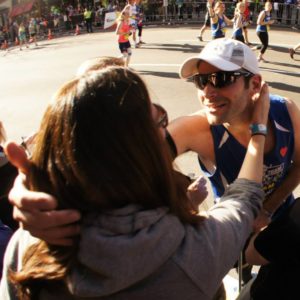
Foley’s biggest supporter is his wife Kate. Submitted photo
him out there. We usually make a day of it and make sure they have fun. He makes it a priority not to let his training interfere with family time. Most of his training takes place before the rest of the family is up and moving. On Saturday mornings, he sometimes runs to and from the kids’ soccer games so he can be there and still gets his long run in. Some of his closest friends are runners, so it is the time that he catches up with friends.”
With the support from his family and friends, Foley was ready to train with Tedy’s Team. He had a good running base going into that December. His pre-marathon workout consisted of a mixture of cardio, weight training, and calisthenics. On Mondays and Wednesdays, he focused on short runs about two-to-four miles. On Tuesdays and Thursdays, he took advantage of cardio and strength classes offered at his work gym. The strength training included fifteen minutes of weights and fifteen minutes of core-strengthening like plank jacks, jumping jacks and other quick hit aerobic exercises to fortify his upper and lower body muscles.
When the first week of December came, Furey scheduled a long run regiment every Saturday. “It started small,” Foley said. “And then it would slowly build over the weeks.” The long runs started between six to eight miles for the first week, eventually reaching 21 miles about three weeks prior to the marathon. “For whatever reason, when I started training for this Boston Marathon, I focused a lot on distance versus physical strength,” he said. “I was just making sure I could do the runs.”
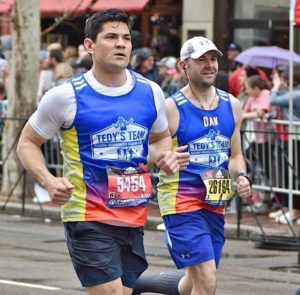
Running with Tedy Bruschi and Tedy’s Team. Submitted photo
The focus each week was to simply complete the longest running set scheduled for a particular week. For instance, if the schedule called for six-to-eight miles, “I would typically do eight,” he said. If the next week called for eight-to-ten miles, “I would do ten.”
The Saturday runs would build from December to mid-January. By that time, no runs would dip under ten miles, but the distances would fluctuate. For one Saturday, they would run ten miles with the following Saturday being 14-to-16 miles, but then drop back down to ten miles again the next week. “I would drive up to Boston from Uxbridge every Saturday morning,” he said. “I’d probably leave my house between 5:30 and 6 and the runs would typically start from 7:30 to 8. We’d get together in the mornings and the coach would give us a pep talk on what the course looked like. He’d warn us about the weather conditions typically the night before so we knew how to dress. He’d have water stops along the way so we wouldn’t have to run without hydration or anything like that … he would have that prepared along the course for us.”
The Dreaded Hill Runs
All the training runs were done on the Boston Marathon course. Foley said on the shorter days, “we’d run out from Heartbreak Hill and then run back.” Heartbreak Hill is an ascent of 0.4 miles between the 20- and 21-mile marks of the course near Boston College. “It was a shorter run but we were experiencing a lot of hills,” he said. The last of the four, known as the Newton Hills, starts at the 16-mile mark and it challenges runners with late climbs. This incline becomes difficult because runners get used to the mostly downhill trend of the course to that point. “The coach was trying to get us ready for race day; trying to build muscle memory,” he said. “We were actually running on the course. He wanted our bodies to know what the terrain felt like.”
Later in the training season, the coach posted hill runs on Wednesday nights in Boston to run up and down the knolls and peaks of the Beacon Hill and Boston Common areas just outside the state house. Foley was not always able to participate in Wednesday hill runs due to work commitments and the fact he now had a one-year-old daughter. “The one thing the coach wanted us to focus on was hill runs because Boston is very hilly,” he said. “However, that first year I truly focused more on just getting the long run in and I really didn’t get into the hill runs.”
Foley continued with his long run training as well as his pre-training gym workouts. “I worked in Worcester … it would take too much family time to go out to Boston and back,” he said. “My workouts were more in the morning at the gym. I would get to the gym at 6 a.m., workout, I’d run around the Hanover campus or I would do them on the treadmill, shower, and go straight to work. That’s kind of how that whole season played out for me.”
The First Marathon
When race day came, Foley quickly learned the importance of hill runs. The Boston Marathon had a significant downhill the first couple miles in Hopkinton and then a slow build-up. “I just remember when I got to Framingham-Natick, there was a little hill,” he said. “There was a Wendy’s or BK to my left and I remember going up that little hill and thinking, ‘I’m in trouble.’ My quads were dead. That was just the start of the uphill and because of all the downhill in the beginning, my legs took a beating and they were not prepared adequately for that. So, it was very clear to me why the coach did those integral hill runs on Wednesday nights and how much I wish I had done that … I never realized how different those first six miles were to the rest of the marathon and I took a beating.”
He finished that race in four hours and thirty-two minutes. “I was pretty lucky. No injuries, except for a little soreness here and there, but I made it.”
Foley did not run his next marathon until Boston 2012. For this one, he trained differently. He did more leg strengthening, including a lot of squats and lunges at the gym. He also built in the important hill runs on Wednesdays. “I couldn’t make Boston hill runs, but the Hanover parking lot has a fairly significant incline, so I did my own hill intervals every Wednesday morning at 6 a.m. My gym was right on the hill. I would run the gym parking lot all the way down the hill for a quarter mile and then I’d turn around and run back up.”
Sometimes he would change the increments of the hill runs, but he would be close to five miles for hill runs by the end of training. “That was probably the strongest I ever felt,” he said. “I was a lot younger. I was a lot fitter and I was very ready for that marathon. My pace had sped up. I was easily targeting a sub four (hour) marathon. My last 21-mile-long training run was great. Everything just lined up to be perfect.”
However, Foley failed to account for the 90-plus degree weather on race day. “That crushed me,” he said. “You train all winter and race-day is 90 … It was
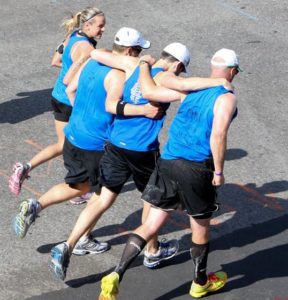
With a little help from his friends, Foley finished the 2012 Boston Marathon. Submitted photo
really bad that day. I was trying to drink at every water stop, but there was a point where my body couldn’t take in anymore water.”
He tried using Clif Shot Blox to fuel his muscles with carbohydrates during the race, because that’s what he used during training. He took two shots about every 45 minutes. “I remember when I took my second round of Shot Blox, I couldn’t swallow them. I knew they were going to come back up. I wasn’t feeling good … there’s a part in Natick where there’s a scaffolding over the race and they take photos of you as you are running under. You can buy them at the end of the race.” When Foley looked up to wave at the photographer and then looked down at the paved course ahead, he became dizzy. “My head and legs just didn’t feel right.” Along with the nausea, he was forced to deal with debilitating calf cramps. “I had the worst calf cramping hit me on Boylston Street. It was paralyzing,” he said. “I needed my teammates’ help for a moment to even go a couple steps. Right on Boylston Street I stopped. I had a teammate on each side of me basically walking me toward the finish. As we approached the finish line, I was able to get my legs to move a bit. After we crossed, my legs stopped moving again,” he said, smiling and laughing. He finished the race in five hours and seven minutes, but “at that point I was just happy to get to the finish.”
Foley realized it was a good year to run with teammates. “One of my teammates in particular, he was struggling early on in the race, so I stuck with him and by the time I got down Heartbreak Hill, I didn’t know if I was going to make the finish and I needed him to push me to the finish … That was the moment I realized that marathon running is more than just an individual sport. Sometimes you just need comradery.”
Lawrence and Sanger are beneficiaries of Foley’s running partnership. “We were, and continue to be, there for each other,” Lawrence said. “When you plan to meet in the dark at 6 a.m. on a Saturday in the dead of winter to run 18 miles, you had to show up because you couldn’t let the other person down.”
Sanger felt overwhelmed when she first started to run with the team. “When I started running, I wasn’t really a fast runner at all,” she said. “I just liked to run and felt intimidated by the faster paces of others and didn’t want to put myself out there at a slower pace against others on the team. But Dan’s encouragement got me there. He is always such a positive and encouraging friend.”
With a little help from his friends, Foley quickly got back on track later that year, finishing the Marine Corp marathon in Washington D.C. at a blistering four hours and four minutes pace, only to be sidetracked later by injuries. “Injuries caught up with me physically in 2012,” he said. Foley’s goal to add leg strength with hill runs led to a painful case of plantar fasciitis, an inflammation of the ligament that connects the heel bone to the toes. Other than the pain, it had little impact on the results of the Boston and Marine Corp races. Nevertheless, the issue led to a worse injury.
The pain spread to his knee. “It was kind of slowly coming on,” he said. “I was diagnosed with a Baker’s cyst.” A Baker’s cyst is a fluid-filled cyst that causes a bulge and a feeling of tightness behind the knee. The pain increases when the knee is fully extended. “I didn’t spend nearly enough time stretching, foam rolling (which can be an effective technique to relieve muscle tightness, soreness, and inflammation), and breaking down the scar tissue. All those things they tell you you’re supposed to do, I didn’t have time for that. I wanted to run and strength train, not roll and stretch,” he said as he chuckled.
The injury sidelined Foley for about a month with a consistent regiment of ice and rest. Although he had some improvement, he dealt with severe foot pain, on and off, for about two years. He was able to compete in the Marine Corp race, but at about mile 22, the pain in his foot kicked in. “It literally felt like I snapped something in my foot. I got a phone call from my wife in that marathon. I was probably at mile 24. ‘I don’t want to alarm you,’ she said, ‘but I just got an alert that you have to pick up the pace a little bit if you want to get under four.’ I told her I can’t do that right now. Thanks for watching out for me.”
Despite the pain, he had another reason to finish the race quickly. “It was Oct. 2012, literally the day before Hurricane Sandy hit. I remember it was windy and my dad and I had to get right in the car to drive home from D.C. and through New York before they closed down New York City. I remember driving home after and we were the only car on the (Alexander Hamilton) Bridge. It was a really eerie feeling.”
Foley never officially tore anything in his foot and was able to fight through the pain to finish another marathon. “Yeah, at that point, I really needed to finish the race. I had come down to Washington DC for it. I was trying to break four hours. I wanted under four really bad. I came close at the Marine Corp, but I didn’t quite make it.”
He followed that up with a respectable 4:21 time at the LA Marathon. This was one month before the 2013 Boston Marathon, but his goal of breaking four hours was increasingly elusive with each race.
Since then, Foley reexamined the fuel he put into his body. For starters, he focused on better hydration and diet to help avoid severe cramping during races.
Hydration
“I sweat a lot so I lose a lot of salt,” he said. For about seven years into his training, he first took a salt tab at the start of races and then again on mile thirteen. From 2018 forward, he switched to a Nuun Tab, a hydration product. Nuun Tab’s are supposed to be dropped and dissolved in water to drink. “I actually take the tablet, break it in half, and I let the tablet dissolve on my tongue. I just wash it down with water at a water stop. I don’t think I’d recommend it. People think I’m crazy for doing that. It just works for me to stay hydrated.”
Diet
When it comes prerace meals, he eats a baked potato, steamed broccoli, and a grilled piece of chicken. This has been his most recent supper routine the night before any marathon. “That’s the prerace ritual for me now,” he said. “Some people carbo load on pasta, but that wasn’t working for me. I had some health issues with my stomach where I had to figure out if I had a Gluten allergy or something. Since then, I’ve tried to stay away from dairy and wheat.”
Foley is not one to pass on any kind of sugar consumption, the night before a half marathon in Hyannis in 2011, his prerace meal consisted of his daughter’s first birthday cake. “I did not eat well the day before of that race,” Foley said. “Too much cake amongst other things.”
Foley used to eat bagels when he was into carbo loading before a race, but now he will eat a banana and an RX Protein bar. Every thirty-five minutes during long runs, he takes a runner’s power gel or goo that contains 100 calories, caffeine and sugar that burns quick in the body for a boost. “You have to really find out what works for your stomach. During the shorter runs at the beginning of the season is where you figure that out,” he said. “I originally started with something called sports beans, which are really like jelly beans with caffeine … For whatever reason, my body got to a point where it couldn’t take them anymore. That bothered my stomach so I had to switch to shot blox and once that 2012 marathon happened when I thought they were coming back up, I have not tasted a shot block since that day. I just couldn’t do it. I’ve really been using goo since, but I’ll be honest, my last marathon in Providence, again it was warm and towards the end of that marathon, I couldn’t stomach those again so I don’t know, I haven’t tried one since then … We’ll see what happens, but it’s more of a mental thing I think.”
Eating during a race can not be underestimated. “If I feel myself getting hungry during a race, I’ve waited too long and it’s almost too late at that point,” he said. Foley makes himself eat every 35 minutes. He times his eating around the water stops to wash down any food. Usually, around mile 18, he’ll eat half of a banana to last the rest of the race. “Any fuel I’m using during a race, I’m using during those long runs in preparation for the race, so my body is ready for it and I know how it’s going to react.” Bananas are the only thing he hasn’t switched up since he started. “I take the banana more for the potassium. Early on, I had a problem with cramping and the potassium helps stop it.”
Finally, Foley has included “intermittent fasting” into his eating habits. He would not eat until 11 a.m. He only allows himself to eat his food between 11 a.m. to 8 p.m. “This is something new I’ve tried the last couple years. So, if I ran before then, if it was just a short run, like seven miles or less, I really didn’t eat anything, but if it was anything over that I would typically eat just a banana and this past year I started eating a protein bar before my run. I really only have that window to eat.”
His diet has evolved from birthday cake to the aforementioned potato, chicken, and broccoli meal, but by no means is he a diet expert. “I think if someone reads this and they know anything about a runner’s diet and they can give me feedback, I’m open to it,” he said. “This is just the last piece I just haven’t figured out, yet … that’s where I struggle.”
Drive to Break Four Hours
With number forty seemingly in the far distance, Foley’s drive for the longest time was centered around breaking four hours. But in 2013, accomplishing that goal seemed trivial in Boston. Foley was less than a mile from the finish line when he was stopped in Kenmore Square as explosions went off at the finish line. On Patriots’ Day, April 15, at 2:49 p.m., two bombs detonated about 210 yards apart at the finish line on Boylston Street near Copley Square. Windows on adjacent buildings were blown out.
“That was 2013. That was rough,” he said. “I don’t know that it affected me as far as the training itself. It kind of got into my head a little bit. I can remember one run in particular when I was training after the bombing had happened. I would just think about what could happen the next time I would cross the finish line. I thought about what that would feel like … There were moments where it was going to be the most exciting moment of my life because we were back and we were doing it and then there were moments where it was going to be the scariest moment of my life. I did not think I was going to be able to do it. There was definitely a level of anxiety that came with that and I think training and going out for the long runs probably helped me cope with that a lot because it gave me time to think and it gave me time to work out my feelings. The alternative was letting it all bottle up and come out while running onto Boylston Street … so it kind of preps me for how it would be when I get to that point if that makes sense.”
Since then, running has always been therapeutic, but the goal of breaking four hours never disappeared. After some time, it crept back into the forefront of his mind. The goal then became an obsession. Following the 2013 Boston Marathon, he went on to compete in nineteen marathons, bookended by the Big Sur on April 28, 2013 and Providence on May 7, 2017. Unfortunately, the closest he came to breaking four hours was a 4:06 at the Bay State marathon on Oct. 18, 2015.
Unable to break four hours, Foley decided to change his approach to training. He strictly did strength and cardio during the week and then ran once a week. He
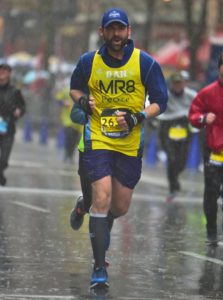
Running for the Martin Richards Foundation in the rain. Submitted photo
would typically take Sundays off. On Mondays, he either ran on an elliptical or used a Stairmaster at the gym. His strength workouts were slated for Tuesdays. He worked with a personal trainer on different kinds of agility workouts on Wednesdays. He spent time on Thursdays in a gym class. Fridays were another off day until his long runs on Saturdays. “That was the only run I would do the entire week,” he said. “I honestly don’t know what made me try that, but my fastest marathons came in 2018 with that approach,” he said
“I had set my PR (personal record) in September at the Clarence DeMar Marathon at 4:01 … Two weeks before C.D., I ran a 4:04. It was like bam, bam! I just kept getting faster … I was really strong. I was fit.”
There was something to this new training approach that got Foley the results he was striving for. He said with his desire to break four hours, coupled with his involvement with a new charity, his motivation to run was on overdrive. “My body was just really well rested,” he said. “I think it was my five fastest races ever … I just had a different passion and motivation that year.” He decided to also run that year for the Martin Richards Foundation, a charity that works to advance the values of inclusion, kindness, justice and peace. The foundation invests in community programs that broaden horizons for young people and encourage them to celebrate diversity and engage in positive civic action.
“I wish I remembered why I decided to take that training approach,” he said. “It may have been just not having enough time to get runs in because of the strength program I was doing, to be honest. And when I did my typical March marathon, it worked out really well, I just kept going with it.”
Two weeks after the Clarence DeMar Marathon, Foley let his momentum take him to the Bay State Marathon on October 21, 2018. This was his 30th marathon and his fastest. He finished the race with his personal best time of 3:56:23. He finally broke four hours. “It was one of the greatest feelings in the world,” he said. “It had been something that I had been chasing since marathon number two and to finally get it, it felt great.”
Breaking four hours also filled Foley with confidence. “It made me finally realize that I was going to hit my goal of 40. I felt since I could hit that goal and break four hours, I could do anything.”
Foley was poised to complete his goal. Not even the COVID-19 pandemic could stop him. “As 2021 was approaching and this was my 40th year and if I was going to make this goal, I needed to be a little bit healthier,” he said. “So, we bought the Peloton treadmill. We bought weights, a Peloton bike and I just started doing my 2018 training regimen again … Just this time, it was virtual.”
Three days a week, he rode his virtual bike and ran on his treadmill, joined by his friends on a virtual screen. “It was good to keep me motivated,” he said. He did virtual strength classes two days a week. He did this for three months straight. “This was getting me to the 40th finish line.”
He just had one more marathon. It was number 39 and it was virtual; scheduled for April 10th. “I knew May was going to be in person and I knew I wanted the in-person race to be my 40th and not virtual.”
Foley received his first shot of the COVID vaccine just prior to the April race. He ran it on the Boston course with some of his Tedy’s Team friends. “It felt great to be on the course again,” he said. “I felt strong throughout the race. I recovered really well and it was what I wanted to go into May with … I’m not nearly as fast as I was in 2018 but my April virtual marathon worked well.” He finished the April 10th Salt Lake City virtual marathon with a respectable time of 4:34:37.
He then got his second vaccine shot one week before the May 2nd race. “So, everything just lined up perfectly,” he said. “I knew I was vaccinated. I knew I was safe. I knew my training had worked out and it just came down to race day … My plan worked. It got me to the finish line.” He finally achieved his goal by crossing his 40th finish line with a time of 4:46:42.
“I did it.”
The accomplishment even impressed the three-time Super Bowl Champion. “It’s been great to watch Dan grow as a runner, and to witness his passion for our cause, and this sport,” Bruschi said. “To see him achieve his goal of running forty marathons before turning 40, is pretty special. Running forty marathons is a feat in itself, but doing it in such a short amount of time is an incredible accomplishment.
“All of us at Tedy’s Team are proud of all he’s been able to accomplish,” he said. “And hope that he continues to enjoy running, and making a difference in his community.”
But What’s Next?
In order to continue, he needed to find the motivation to do so. A month following the Tony’s Pizza conversation, Foley’s desire to lace up his running shoes did return. He was now on the Uxbridge High School track stretching. The weather was about 60-degrees and the sky was gloomy and overcast, but not his spirit.
“When I was training regularly for Boston I would come here once every Wednesday,” he said. During those sessions, he did a couple laps around the track.
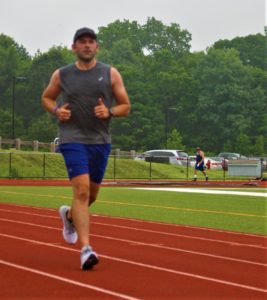
Back in Training in Uxbridge. Photo by Kevin Paul Saleeba
With the high school entrance driveway slanted on a significant incline, he then ran up and down it for his hill runs. He did hill repeats for a mile and then back to the track for a couple more laps until he reached about 10 miles. “That would get me prepared for Heartbreak Hill and the downhill at the start of the race. Now, I’m trying to get back into that. I’m going to do two right now and I feel good.”
Marathon Monday is now October 11. “That’s not much time,” he said. “I keep telling people I’m having my midlife crisis because I’m about to turn 40. Today, I’m kind of experimenting with it again. It’s literally my first time here in years. Since the 2018 marathon, I haven’t done this routine. I think I told you before, my 2018 plan worked best for me so I’m trying to get back to that.”
This time, he is not hitting the pavement to break a personal record. He was not supporting a charity. This was different. He wanted to run for his kids. Through it all, starting with his wife, running has always been about his family.
Lawrence experienced it firsthand. “We spent a lot of time together and talked for hundreds of hours,” he said. “The constant theme was how much he loved his family and only wanted the best for them.
“Dan is a genuine, good guy and role model – both in running and in life. I feel blessed to know him and call him a friend. I know he will continue to run because it brings him joy, especially when he is running for a cause – something personal to him. I will continue to follow Dan’s journey and run with him every chance I get.”
There is no bigger supporter than his wife. “We’re all proud of him,” she said. “As he looks beyond his 40th marathon and at setting an example for our kids, I think he forgets that he has spent a decade modeling all of these great things for them. Paige and Theo have grown up in a home where being physically active and supporting causes you care about are part of our routine. I love that they have been living it through the lens of Dan’s generosity, commitment and sportsmanship.”
Running is indeed more personal for Foley. He has even enjoyed watching his 11-year-old daughter, Page, and nine-year-old son, Theo, compete in the occasional 5K. “I hope I’ll be running more with them,” he said. “My daughter has been around it for 11 years and it’s become her life as well. Particularly the charitable aspect. She’ll make some kind of craft and would want to raise money for a charity. It’s just what she knows.
“They both love being a part of the fundraisers we do,” he said. “They love going to the races, cheering on teams, and I hope that continues to grow … I would love to see them do that and then I could support them versus them supporting me. I’d like to watch them run.”
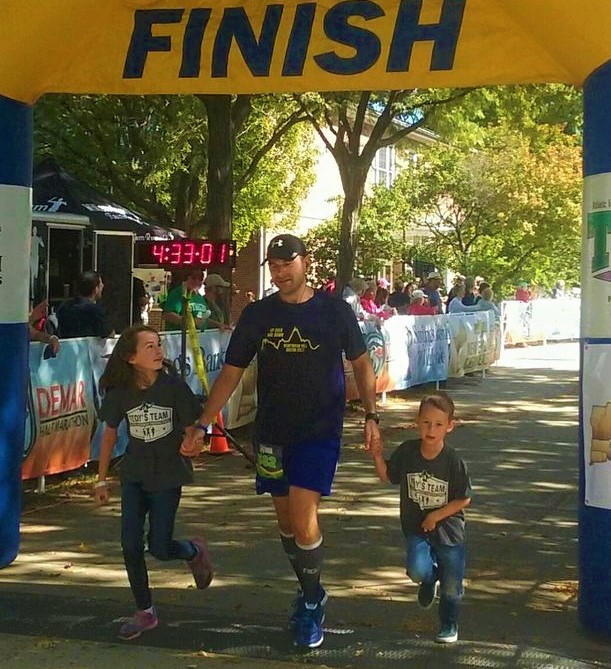
Crossing the finish line with Paige and Theo in Boston 2014. Submitted photo


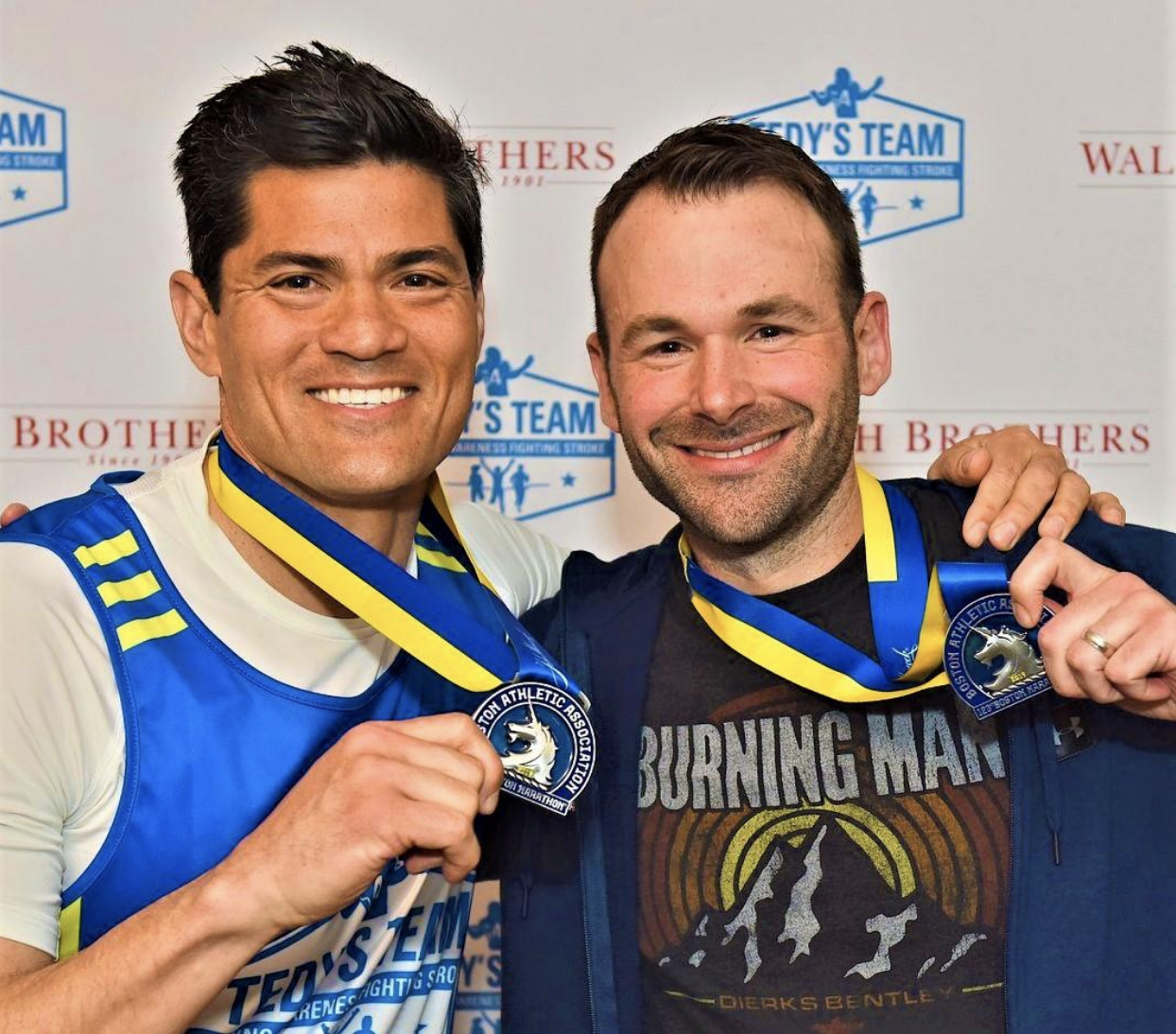
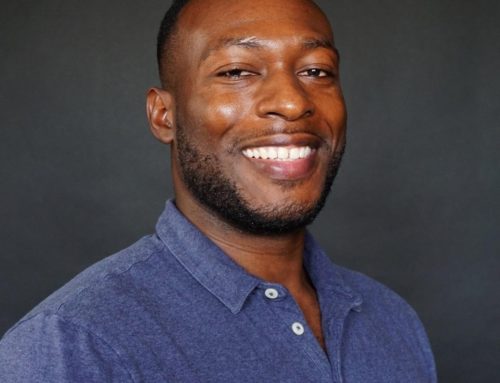

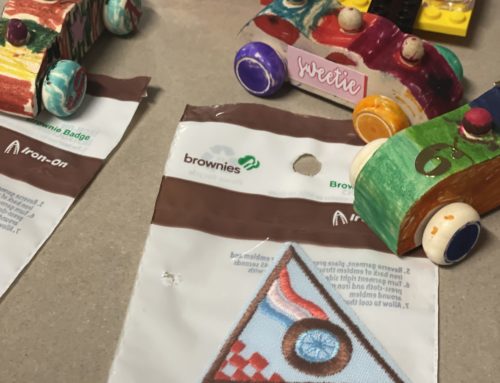
Leave A Comment